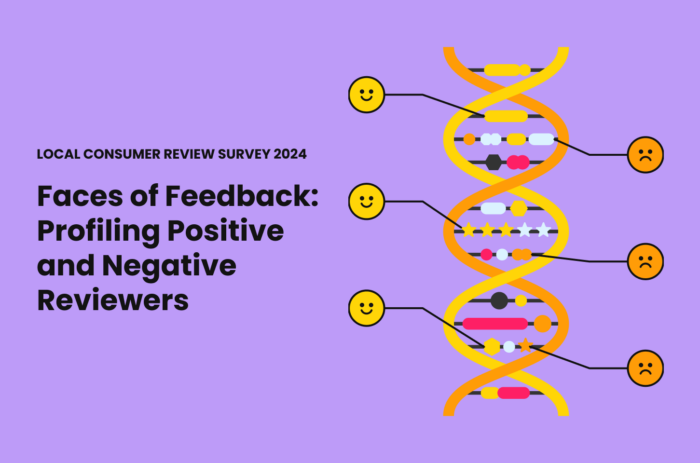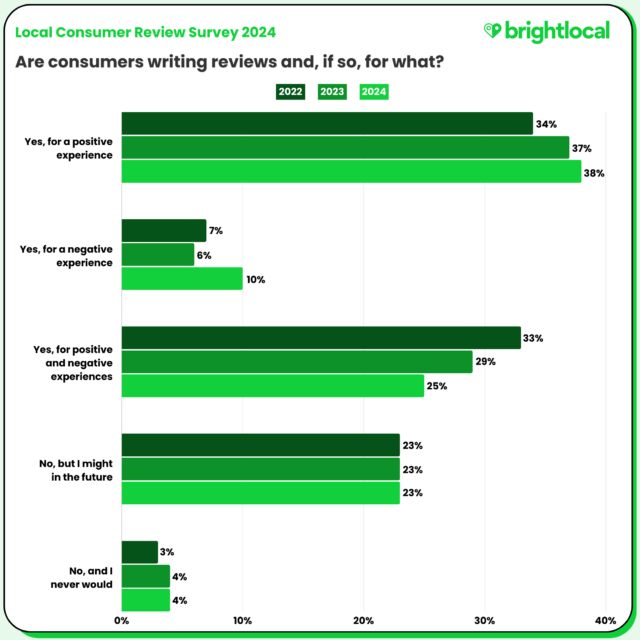As humans, we like to stereotype people. According to Zhang et al., it stems from a basic need to simplify and categorize otherwise complex things in the world. And, maybe in some cases, we even like the sense of belonging.
I, for one, tend to take comfort in the shared characteristics of my fellow specialty coffee-swilling millennials… well, mostly.
The thing with stereotypes, though, is that they can cause us to assume things about people. And in many cases, there can be negative associations with such groups.
When we conduct the annual Local Consumer Review Survey, we examine the results to look for patterns around demographics like gender or age. Do younger consumers search for reviews online more regularly than older groups, for example?
The 2024 report pointed to several key themes among consumers, such as a sense of fatigue from being prompted for reviews too often and wariness of taking what they read at face value. Yet, while 73% of consumers had written a business review in the last year, it was interesting to note that some consumers lean towards only leaving positive reviews, while others lean towards only leaving negative ones.
In fact, we found that the percentage of consumers only leaving positive or negative reviews had grown year on year.
So, what type of person only writes a positive review, and are they very different from those who only write negative reviews? Why would someone specifically only leave positive or negative reviews? What kind of crusade are they on?
Let’s take a look. Some of the findings might just surprise you. Have a look at the profiles we’ve put together below, or scroll down further for a breakdown of the findings.
A Note on Gender Representation
The first interesting point to note is that there was no clear gender divide across either Positive Reviewers or Negative Reviewers. In much earlier iterations of the survey, we found notable differences in how male and female survey respondents read and write business reviews. In the years since, these gaps have become lesser and lesser, to the point where we no longer see any key differentiators.
Of course, it’s also important to recognize the limitations of gender within survey platforms. Although SurveyMonkey polls a representative sample of US consumers, we must acknowledge that it only provides the option of ‘male’ and ‘female’ to participants.
The Positive Reviewer
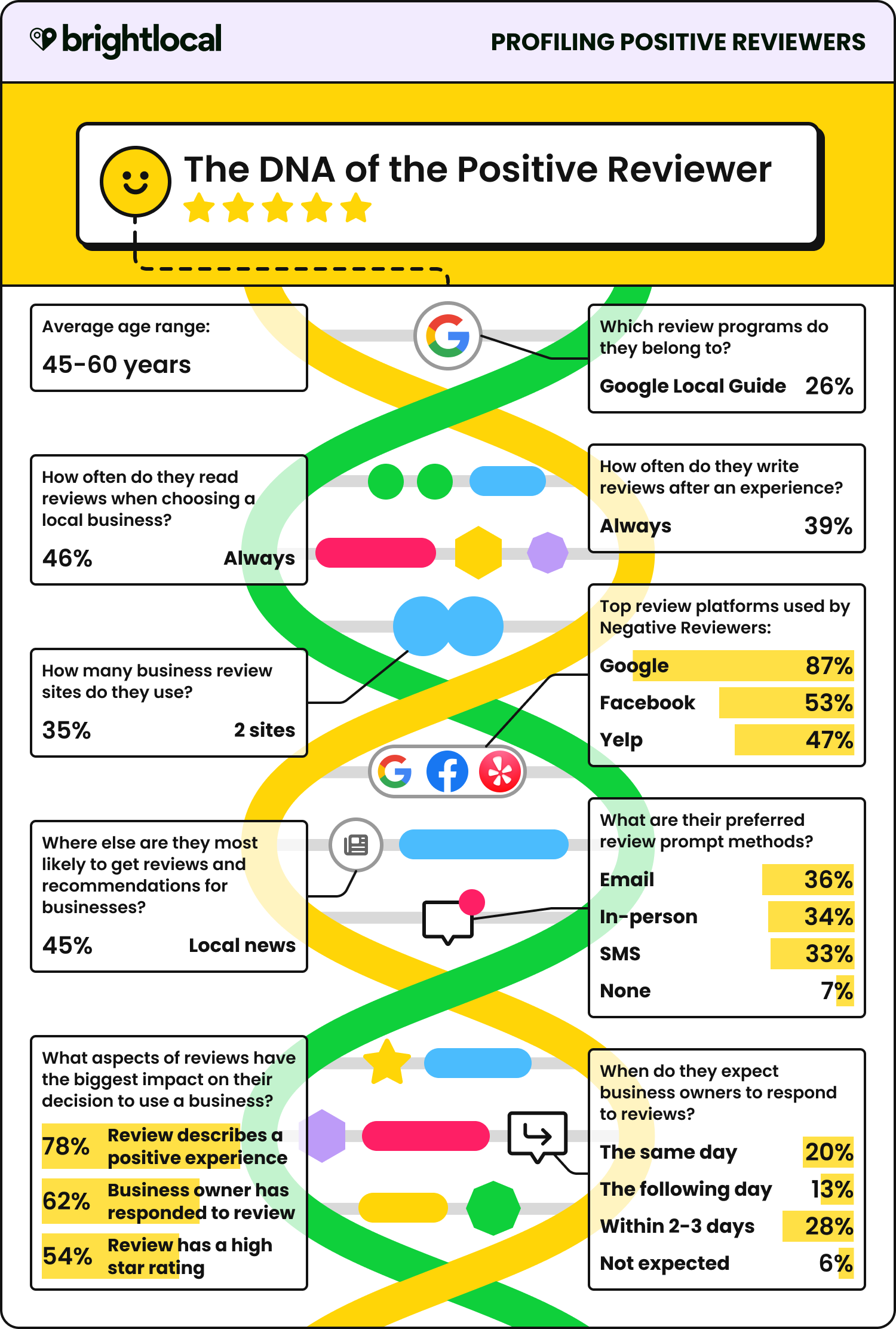
Going back to our stereotypes, you might assume that older consumers would have less patience and, therefore, be more likely to leave negative reviews. Our results showed quite the opposite, as 45-60 year-olds were the largest age group of Positive Reviewers.
Typically, the Positive Reviewer will ‘always’ read online reviews when researching local businesses and will ‘always’ write a review after an experience. This commitment shows us that they have faith in the review system, so their motivation for leaving reviews probably stems from a desire to contribute to the system and be helpful by sharing their experiences.
It’s very interesting, though, that when we consider they always write business reviews, these reviews are also always positive and not a mix of sentiments.
Does the Positive Reviewer simply never have a bad experience? Or, are these reviewers determined to always find the positive in any given situation?
The top factor that impacts the Positive Reviewer’s decision to use a business is reading other reviews describing positive experiences. So, it could be that they are more careful in the businesses they choose and that they spend time reading the written content of reviews.
Additionally, the Positive Reviewer likes to use local news as an alternative platform for business reviews. While this could be in digital or print form, it tells us that the Positive Reviewer views business information printed or published by a local news authority as trustworthy and credible.
When we consider that they use two platforms on average to read business reviews, they could be verifying reviewer-written content with information found in local news.
The Negative Reviewer
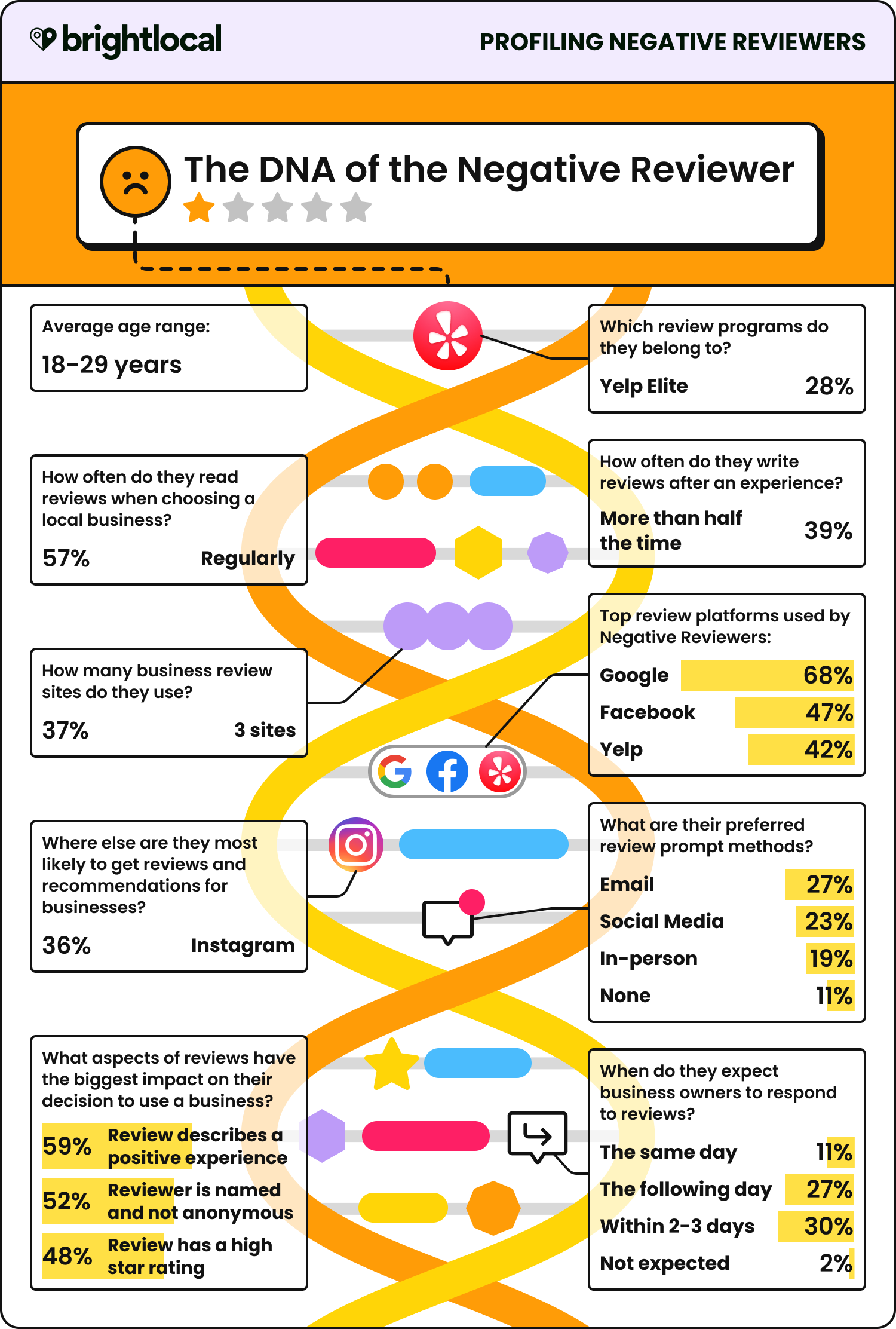
It might surprise you that the Negative Reviewer tends to be between 18 and 29 years old. With this in mind, though, it likely won’t come as a surprise that they tend to use Instagram as a top alternative reviews/recommendations platform.
This reviewer type reads online reviews ‘regularly’ as part of their local business research and generally writes a business review more than half the time. So, while reading business reviews is an important part of the research process, Negative Reviewers do not feel compelled to ‘always’ write business reviews when they’re asked to.
At a glance, the Negative Reviewer appears less trusting than the Positive Reviewer in that they typically check more review sites (three) and expect to see named reviewers in order to trust their review content. So? This tells us that trust indicators are important to them, which means you must give them a reason to trust your brand.
While you can’t control the content of customer reviews, you can ensure you maintain consistent reputation management profiles. That means ensuring your brand is present across a range of review platforms and dedicating enough time to generating reviews across all of them. If the average Negative Reviewer checks three review platforms, and the reputation score is wildly different on each one, that isn’t a good indicator of trust.
Build a 5-star Reputation
Collect, monitor, and respond to reviews with ease
Positive vs. Negative: Findings Breakdown
Some of the findings don’t stand out as a particular trait belonging to either profile, but we can compare them side-by-side to highlight similarities and any other areas that might be worth discussing.
Reviewer Type by Age Group
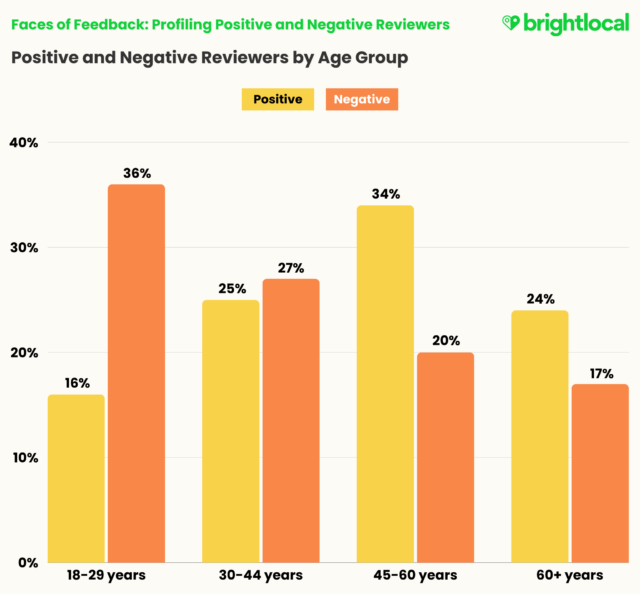
- 63% of Negative Reviewers are aged between 18-44 years.
- 58% of Positive Reviewers are aged 45+.
If we consider why a consumer might be driven to write a negative review, it’s likely an emotional response to things like bad customer service. The consumer is reacting to disappointment, maybe even feelings of injustice.
The 18-29 years age group was the largest segment of negative reviewers (36%), with the chart reflecting a decreasing trend across the older age groups.
Although we don’t know exactly why this might be, it could be that, as digital interactions are so ingrained among 18-29-year-olds, leaving a review for a bad experience feels like a natural first port of call for this age group.
Review Reading and Writing Frequency
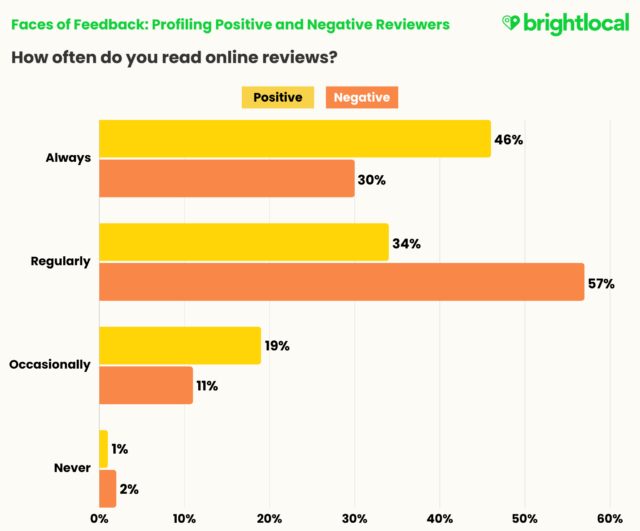
It seems surprising that 19% of Positive Reviewers only read reviews ‘occasionally’ as part of their local business research, compared to 11% of Negative Reviewers.
However, looking at this through a lens of trust might suggest that some of our Positive Reviewers are just happy to find a local business and give it a chance based on first-hand information they find. This could be a brand’s website, owned social media profiles, or official business listings, for example.
For Negative Reviewers, this could further indicate that they are more mistrustful and want to make sure they are reading multiple sources before making a decision.
Top Review Platforms Used to Evaluate Local Businesses
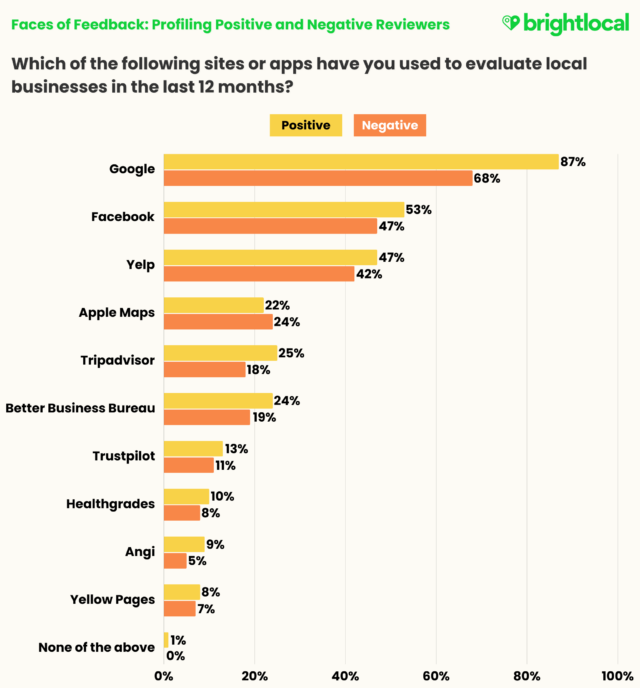
Google, Facebook, and Yelp are the top three platforms used by both Positive Reviewers and Negative Reviewers.
What’s most interesting here, though, is that we also know almost a third of Negative Reviewers are members of the Yelp Elite program. So, why is Yelp not number one among Negative Reviewers? And why do only 42% of them use Yelp, compared to 47% of Positive Reviewers?
It is possible that people are members of Yelp Elite because of the perceived and exclusive benefits the program offers but do not actually use the platform that often to evaluate other business reviews.
The only platform that it seems Negative Reviewers use more than Positive Reviewers is Apple Maps.
Alternative Platforms Used to Find Business Reviews
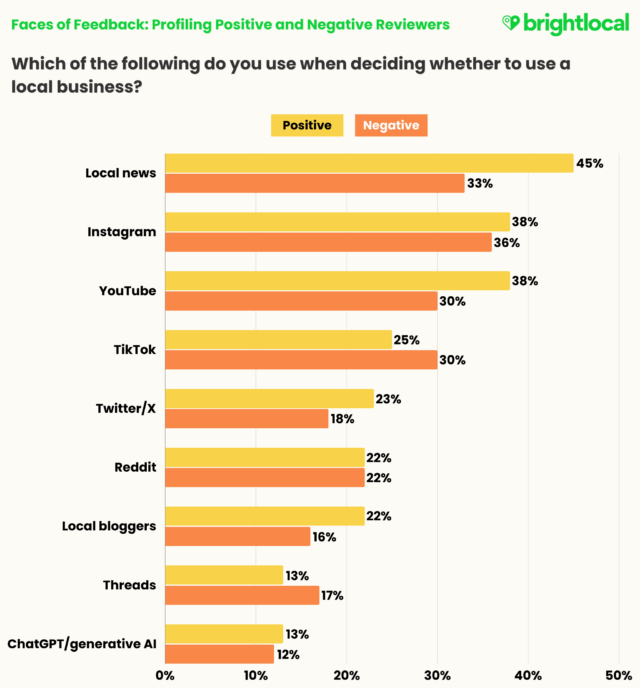
- Positive Reviewers use local news significantly more than Negative Reviewers to find local business reviews and recommendations.
- Negative Reviewers appear more likely to use newer social media platforms like TikTok and Threads as alternative sources of local business information.
Important Review Factors
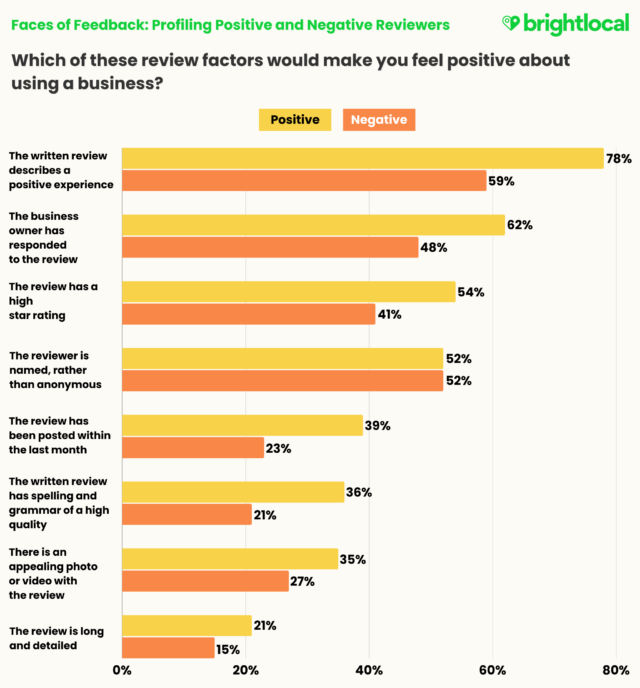
The factors that are most important to positive and negative reviewer types generally reflect the pattern and order we saw in the main report, with written positive experiences by far standing out as most important. This tells us that both Positive Reviewers and Negative Reviewers are spending time reading—or at least skimming through—the content of reviews.
Yet, while this review factor is top for both types of reviewer, their motivations might be very different. As we’ve posited, the Negative Reviewer might check review content across multiple platforms because they are naturally less trusting.
For Negative Reviewers, the second most important review factor to them is seeing reviews are written by named users, instead of anonymous profiles. Again, this points to a sense of wariness or mistrust in the information they’re finding online, potentially conflating anonymous reviews with inauthenticity.
‘High’ star ratings are deemed important to both reviewer types, although it’s worth noting that it appears more important to Positive Reviewers than Negative Reviewers (54% vs. 41%).
If we examine their expectations for average business star ratings, we see that Negative Reviewers are more likely to use businesses with lower star ratings than Positive Reviewers.
Expectations for minimum average star rating
| The Positive Reviewer | The Negative Reviewer | |
|---|---|---|
| 1.0 - 2.5 stars | 10% | 30% |
| 3.0 stars | 11% | 9% |
| 3.5 - 5.0 stars | 74% | 61% |
| Does not impact decision | 5% | 1% |
You might expect this to be the other way around. But, it could tell us that Negative Reviewers are weighing up other review factors, such as the experiences described in written review content or who is writing them, rather than just taking star ratings at face value.
Why might the Positive Reviewer be more selective around businesses with ‘high’ star ratings? Perhaps it comes back to the earlier suggestion that these consumers are determined to have positive experiences with local businesses and, therefore, won’t take a chance on a business with (what they perceive to be) low star ratings.
Expectations for Review Responses
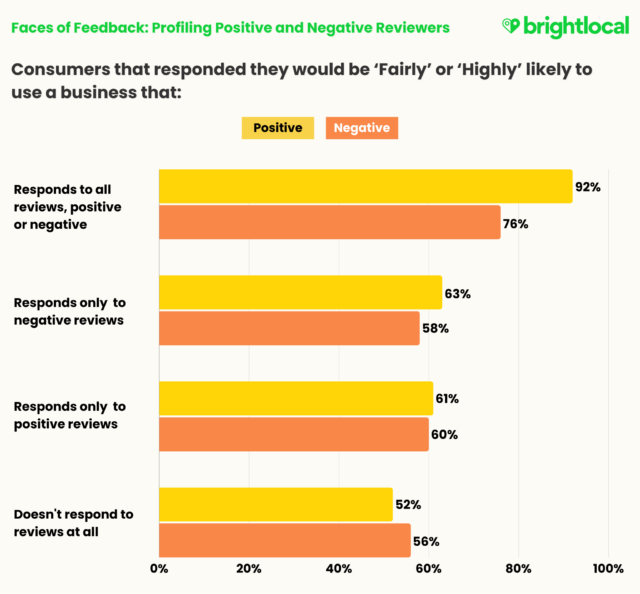
As we know from the main Local Consumer Review Survey report, it’s a significant expectation for business owners to be seen to respond to all types of online reviews, good or bad. That trend is no different here.
Local Consumer Review Survey: Consumer expectations for review responses from business owners
| 'Fairly' to 'Highly' likely to use a business that: | Percentage of Respondents | |
|---|---|---|
| Responds to positive and negative reviews | 88% | |
| Responds only to negative reviews | 58% | |
| Responds only to positive reviews | 54% | |
| Does not respond to reviews at all | 47% |
The fact that both positive and negative reviewer types are looking for responses to all reviews reinforces the importance of monitoring your reputation platforms for new reviews and ensuring review content is properly addressed.
It also suggests that not all is lost when it comes to the Negative Reviewer! They’re not just looking for responses to negative comments and, interestingly, may be more willing than the Positive Reviewer to use a business that doesn’t respond to reviews at all (56% vs. 52%).
Prompting Consumers to Write Reviews
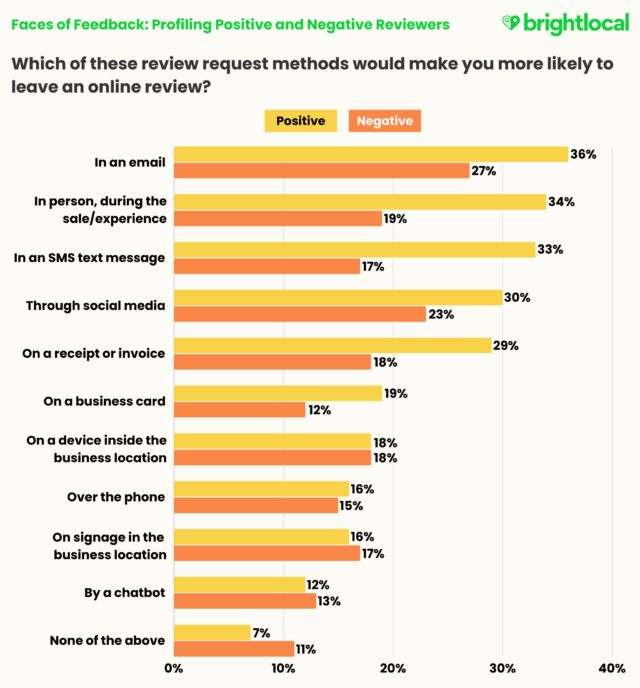
When looking at the review prompt methods consumers would likely respond to, we can see that Positive Reviewers are more receptive than Negative Reviews to six prompt types in particular:
- SMS (16% more than Negative Reviewers)
- In-person (15% more than Negative Reviewers)
- Receipt or invoice (11% more than Negative Reviewers)
- Email (9% more than Negative Reviewers)
- Social media (7% more than Negative Reviewers)
- Business card (7% more than Negative Reviewers)
But, overall, email is the top prompt method for both reviewer types.
Negative Reviewers are more receptive to prompts on social media than to all other methods except email. As discussed earlier, this could show a relationship between younger demographics and their ‘natural’ online behavior.
However, as we’re talking about Negative Reviewers here, it might be worth considering how your brand uses social media as a call-out for reviews. Is it calling out for new reviews in one post while ignoring negative feedback shared on other posts?
What does this mean for your business or brand?
The profiles above may seem a bit of fun (and we’ve aimed to present them in that way), but there are important considerations to take away for your own reputation management strategies.
1. Customer service is key
As highlighted in the main report, the most important step towards generating regular, positive reviews should, of course, be a focus on delivering the best customer experience possible. You need to give your customers something to remember, something to talk about, something that prompts them to write a review that is unique.
2. Responding to all business reviews
The next takeaway is to acknowledge and act on all feedback, good and bad. You can’t change a bad review, but you can do the right thing by responding to it—and be seen to do so. We know that it’s a critical expectation in all consumers’ post-experience journeys, whether they default to a positive or negative reviewer. Not only does it show prospective customers that you actively respond to and take on feedback, but it should be seen as an opportunity to convert your negative reviewers into those who are willing to try again.
3. Opportunities to create brand advocates
Meanwhile, engaging with and responding to your positive reviewers should be seen as an opportunity to nurture advocacy towards your brand. There is plenty of evidence out there that highlights the benefits of repeat custom and customer retention for your bottom line, but with the prevalence of user-generated review content on platforms like Instagram and TikTok, who knows where else positive brand mentions could show up?
4. Consider your review prompts carefully
Finally, on the subject of social media, while it is a method of review prompting that reviewers are receptive to, ensure you are considerate and vigilant in how you manage this. A blanket ‘one size fits all’ approach may not be appropriate here, where responses and engagement are publicly visible.
We hope these profiles have given you some food for thought for how you approach different consumer types.
